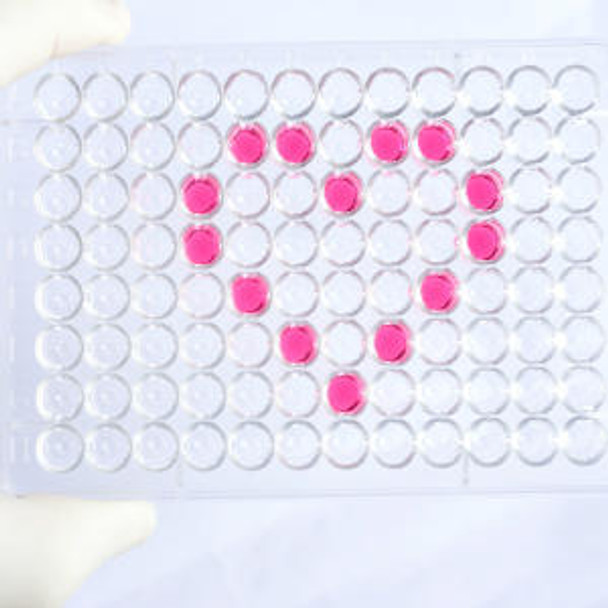Human Isocitrate dehydrogenase [NADP] cytoplasmic (IDH1) ELISA Kit (HUEB1202)
- SKU:
- HUEB1202
- Product Type:
- ELISA Kit
- Size:
- 96 Assays
- Uniprot:
- O75874
- Range:
- 0.78-50 ng/mL
- ELISA Type:
- Sandwich
- Synonyms:
- IDH1, IsocitRate dehydrogenase [NADP] cytoplasmic, Oxalosuccinate decarboxylase, NADP, +-specific ICDH, IDH, Cytosolic NADP-isocitRate dehydrogenase, IDP, PICD, IDCD, IDPC
- Reactivity:
- Human
Description
Human Isocitrate dehydrogenase [NADP] cytoplasmic (IDH1) ELISA Kit
The Human Isocitrate Dehydrogenase (NADP+) Cytoplasmic (IDH1) ELISA Kit is a high-quality assay designed for the precise measurement of IDH1 levels in human biological samples including serum, plasma, and cell culture supernatants. This kit offers outstanding sensitivity and specificity, guaranteeing accurate and consistent results for a variety of research purposes.IDH1 is an enzyme that plays a critical role in cellular metabolism by catalyzing the conversion of isocitrate to α-ketoglutarate. Mutations in the IDH1 gene have been linked to various diseases such as gliomas, acute myeloid leukemia, and other cancers, making it a valuable biomarker for studying these conditions and developing potential treatments.
By using the Human Isocitrate Dehydrogenase (NADP+) Cytoplasmic (IDH1) ELISA Kit, researchers can gain insight into the levels of this important enzyme in different biological samples, ultimately enhancing their understanding of disease mechanisms and accelerating the development of targeted therapies.
| Product Name: | Human Isocitrate dehydrogenase [NADP] cytoplasmic (IDH1) ELISA Kit |
| SKU: | HUEB1202 |
| Size: | 96T |
| Target: | Human Isocitrate dehydrogenase [NADP] cytoplasmic (IDH1) |
| Synonyms: | Cytosolic NADP-isocitrate dehydrogenase, IDP, NADP(+)-specific ICDH, Oxalosuccinate decarboxylase, IDH, PICD |
| Assay Type: | Sandwich |
| Detection Method: | ELISA |
| Reactivity: | Human |
| Detection Range: | 0.78-50ng/mL |
| Sensitivity: | 0.31ng/mL |
| Intra CV: | 5.8% | ||||||||||||||||||||
| Inter CV: | 9.9% | ||||||||||||||||||||
| Linearity: |
| ||||||||||||||||||||
| Recovery: |
|
| Uniprot: | O75874 |
| Sample Type: | Serum, plasma, tissue homogenates, cell culture supernates and other biological fluids |
| Specificity: | Natural and recombinant human Isocitrate dehydrogenase [NADP] cytoplasmic |
| Sub Unit: | Homodimer. |
| Research Area: | Cardiovascular |
| Subcellular Location: | Cytoplasm Peroxisome |
| Storage: | Please see kit components below for exact storage details |
| Note: | For research use only |
| UniProt Protein Function: | IDH1: an oxidoreductase that catalyzes the third step of the TCA cycle: the oxidative decarboxylation of isocitrate, consuming NADP(+), and producing alpha-ketoglutarate (alpha-KG) and CO2. Alpha-KG is an activator the dioxygenases that hydroxylate the transcription factor HIF and lead to its degradation by VHL. Since HIF turns on oncogenic pathways, IDH1 has apparent tumor suppressor activity. Homo-dimerization is required for activity. Each subunit binds 1 magnesium or manganese ion. IDH1 is located in the cytosol and peroxisomes. Somatic mutations affecting arginine 132 (R132) are found in 80% of grade II?III gliomas and secondary glioblastomas in humans, and cause disease in a tissue-specific fashion. Only a single copy of the gene has been found to be mutated in tumours. Mutations of R132 to H, C, S, G, V, or L have been reported to be neomorphic, abolishing the conversion of isocitrate to alpha-KG. Instead, alpha-KG is converted to R(-)-2-hydroxyglutarate (2HG). Elevated levels of 2HG correlate with an elevated risk of malignant brain tumors. Neomorphic mutations in IDH1 and IDH2 convert alpha-KG to 2-hydroxyglutarate (2-HG) occur in a high percentage of patients with cytogenetically normal acute myeloid leukemia (AML). |
| UniProt Protein Details: | Protein type:Carbohydrate Metabolism - citrate (TCA) cycle; EC 1.1.1.42; Other Amino Acids Metabolism - glutathione; Oxidoreductase Chromosomal Location of Human Ortholog: 2q34 Cellular Component: cell-cell adherens junction; cytoplasm; cytosol; peroxisomal matrix; peroxisome Molecular Function:(R)-2-hydroxyglutarate dehydrogenase activity; isocitrate dehydrogenase (NADP+) activity; magnesium ion binding; protein homodimerization activity; receptor binding Biological Process: 2-oxoglutarate metabolic process; isocitrate metabolic process; NADPH regeneration Disease: Glioma Susceptibility 1 |
| NCBI Summary: | Isocitrate dehydrogenases catalyze the oxidative decarboxylation of isocitrate to 2-oxoglutarate. These enzymes belong to two distinct subclasses, one of which utilizes NAD(+) as the electron acceptor and the other NADP(+). Five isocitrate dehydrogenases have been reported: three NAD(+)-dependent isocitrate dehydrogenases, which localize to the mitochondrial matrix, and two NADP(+)-dependent isocitrate dehydrogenases, one of which is mitochondrial and the other predominantly cytosolic. Each NADP(+)-dependent isozyme is a homodimer. The protein encoded by this gene is the NADP(+)-dependent isocitrate dehydrogenase found in the cytoplasm and peroxisomes. It contains the PTS-1 peroxisomal targeting signal sequence. The presence of this enzyme in peroxisomes suggests roles in the regeneration of NADPH for intraperoxisomal reductions, such as the conversion of 2, 4-dienoyl-CoAs to 3-enoyl-CoAs, as well as in peroxisomal reactions that consume 2-oxoglutarate, namely the alpha-hydroxylation of phytanic acid. The cytoplasmic enzyme serves a significant role in cytoplasmic NADPH production. Alternatively spliced transcript variants encoding the same protein have been found for this gene. [provided by RefSeq, Sep 2013] |
| UniProt Code: | O75874 |
| NCBI GenInfo Identifier: | 21903432 |
| NCBI Gene ID: | 3417 |
| NCBI Accession: | O75874.2 |
| UniProt Secondary Accession: | O75874,Q567U4, Q6FHQ6, Q7Z3V0, Q93090, Q9NTJ9, Q9UKW8 |
| UniProt Related Accession: | O75874 |
| Molecular Weight: | 46,659 Da |
| NCBI Full Name: | Isocitrate dehydrogenase |
| NCBI Synonym Full Names: | isocitrate dehydrogenase (NADP(+)) 1, cytosolic |
| NCBI Official Symbol: | IDH1 |
| NCBI Official Synonym Symbols: | IDH; IDP; IDCD; IDPC; PICD; HEL-216; HEL-S-26 |
| NCBI Protein Information: | isocitrate dehydrogenase [NADP] cytoplasmic |
| UniProt Protein Name: | Isocitrate dehydrogenase [NADP] cytoplasmic |
| UniProt Synonym Protein Names: | Cytosolic NADP-isocitrate dehydrogenase; IDP; NADP(+)-specific ICDH; Oxalosuccinate decarboxylase |
| Protein Family: | Isocitrate dehydrogenase |
| UniProt Gene Name: | IDH1 |
| Component | Quantity (96 Assays) | Storage |
| ELISA Microplate (Dismountable) | 8×12 strips | -20°C |
| Lyophilized Standard | 2 | -20°C |
| Sample Diluent | 20ml | -20°C |
| Assay Diluent A | 10mL | -20°C |
| Assay Diluent B | 10mL | -20°C |
| Detection Reagent A | 120µL | -20°C |
| Detection Reagent B | 120µL | -20°C |
| Wash Buffer | 30mL | 4°C |
| Substrate | 10mL | 4°C |
| Stop Solution | 10mL | 4°C |
| Plate Sealer | 5 | - |
Other materials and equipment required:
- Microplate reader with 450 nm wavelength filter
- Multichannel Pipette, Pipette, microcentrifuge tubes and disposable pipette tips
- Incubator
- Deionized or distilled water
- Absorbent paper
- Buffer resevoir
*Note: The below protocol is a sample protocol. Protocols are specific to each batch/lot. For the correct instructions please follow the protocol included in your kit.
Allow all reagents to reach room temperature (Please do not dissolve the reagents at 37°C directly). All the reagents should be mixed thoroughly by gently swirling before pipetting. Avoid foaming. Keep appropriate numbers of strips for 1 experiment and remove extra strips from microtiter plate. Removed strips should be resealed and stored at -20°C until the kits expiry date. Prepare all reagents, working standards and samples as directed in the previous sections. Please predict the concentration before assaying. If values for these are not within the range of the standard curve, users must determine the optimal sample dilutions for their experiments. We recommend running all samples in duplicate.
| Step | |
| 1. | Add Sample: Add 100µL of Standard, Blank, or Sample per well. The blank well is added with Sample diluent. Solutions are added to the bottom of micro ELISA plate well, avoid inside wall touching and foaming as possible. Mix it gently. Cover the plate with sealer we provided. Incubate for 120 minutes at 37°C. |
| 2. | Remove the liquid from each well, don't wash. Add 100µL of Detection Reagent A working solution to each well. Cover with the Plate sealer. Gently tap the plate to ensure thorough mixing. Incubate for 1 hour at 37°C. Note: if Detection Reagent A appears cloudy warm to room temperature until solution is uniform. |
| 3. | Aspirate each well and wash, repeating the process three times. Wash by filling each well with Wash Buffer (approximately 400µL) (a squirt bottle, multi-channel pipette,manifold dispenser or automated washer are needed). Complete removal of liquid at each step is essential. After the last wash, completely remove remaining Wash Buffer by aspirating or decanting. Invert the plate and pat it against thick clean absorbent paper. |
| 4. | Add 100µL of Detection Reagent B working solution to each well. Cover with the Plate sealer. Incubate for 60 minutes at 37°C. |
| 5. | Repeat the wash process for five times as conducted in step 3. |
| 6. | Add 90µL of Substrate Solution to each well. Cover with a new Plate sealer and incubate for 10-20 minutes at 37°C. Protect the plate from light. The reaction time can be shortened or extended according to the actual color change, but this should not exceed more than 30 minutes. When apparent gradient appears in standard wells, user should terminatethe reaction. |
| 7. | Add 50µL of Stop Solution to each well. If color change does not appear uniform, gently tap the plate to ensure thorough mixing. |
| 8. | Determine the optical density (OD value) of each well at once, using a micro-plate reader set to 450 nm. User should open the micro-plate reader in advance, preheat the instrument, and set the testing parameters. |
| 9. | After experiment, store all reagents according to the specified storage temperature respectively until their expiry. |
When carrying out an ELISA assay it is important to prepare your samples in order to achieve the best possible results. Below we have a list of procedures for the preparation of samples for different sample types.
| Sample Type | Protocol |
| Serum | If using serum separator tubes, allow samples to clot for 30 minutes at room temperature. Centrifuge for 10 minutes at 1,000x g. Collect the serum fraction and assay promptly or aliquot and store the samples at -80°C. Avoid multiple freeze-thaw cycles. If serum separator tubes are not being used, allow samples to clot overnight at 2-8°C. Centrifuge for 10 minutes at 1,000x g. Remove serum and assay promptly or aliquot and store the samples at -80°C. Avoid multiple freeze-thaw cycles. |
| Plasma | Collect plasma using EDTA or heparin as an anticoagulant. Centrifuge samples at 4°C for 15 mins at 1000 × g within 30 mins of collection. Collect the plasma fraction and assay promptly or aliquot and store the samples at -80°C. Avoid multiple freeze-thaw cycles. Note: Over haemolysed samples are not suitable for use with this kit. |
| Urine & Cerebrospinal Fluid | Collect the urine (mid-stream) in a sterile container, centrifuge for 20 mins at 2000-3000 rpm. Remove supernatant and assay immediately. If any precipitation is detected, repeat the centrifugation step. A similar protocol can be used for cerebrospinal fluid. |
| Cell culture supernatant | Collect the cell culture media by pipette, followed by centrifugation at 4°C for 20 mins at 1500 rpm. Collect the clear supernatant and assay immediately. |
| Cell lysates | Solubilize cells in lysis buffer and allow to sit on ice for 30 minutes. Centrifuge tubes at 14,000 x g for 5 minutes to remove insoluble material. Aliquot the supernatant into a new tube and discard the remaining whole cell extract. Quantify total protein concentration using a total protein assay. Assay immediately or aliquot and store at ≤ -20 °C. |
| Tissue homogenates | The preparation of tissue homogenates will vary depending upon tissue type. Rinse tissue with 1X PBS to remove excess blood & homogenize in 20ml of 1X PBS (including protease inhibitors) and store overnight at ≤ -20°C. Two freeze-thaw cycles are required to break the cell membranes. To further disrupt the cell membranes you can sonicate the samples. Centrifuge homogenates for 5 mins at 5000xg. Remove the supernatant and assay immediately or aliquot and store at -20°C or -80°C. |
| Tissue lysates | Rinse tissue with PBS, cut into 1-2 mm pieces, and homogenize with a tissue homogenizer in PBS. Add an equal volume of RIPA buffer containing protease inhibitors and lyse tissues at room temperature for 30 minutes with gentle agitation. Centrifuge to remove debris. Quantify total protein concentration using a total protein assay. Assay immediately or aliquot and store at ≤ -20 °C. |
| Breast Milk | Collect milk samples and centrifuge at 10,000 x g for 60 min at 4°C. Aliquot the supernatant and assay. For long term use, store samples at -80°C. Minimize freeze/thaw cycles. |
| ELISA |
| Human IDH ELISA Kit |










